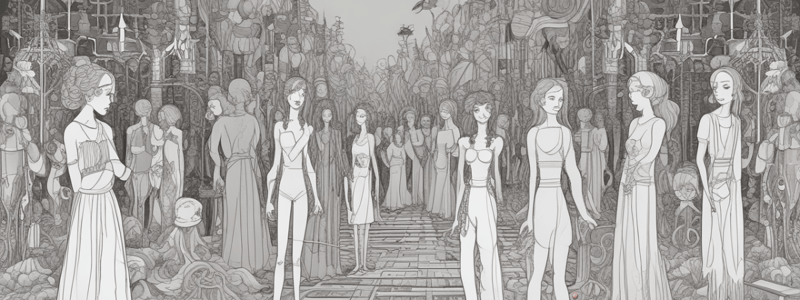Podcast
Questions and Answers
True or false:According to control theories/neoclassical criminology, people do not have free will.
True or false:According to control theories/neoclassical criminology, people do not have free will.
False (B)
True or false: Internal controls are less important than external controls in preventing delinquency.
True or false: Internal controls are less important than external controls in preventing delinquency.
False (B)
True or false: Delinquents use techniques of neutralization to justify their behavior, according to social bonds theory.
True or false: Delinquents use techniques of neutralization to justify their behavior, according to social bonds theory.
False (B)
True or false: The general theory of crime suggests that high self-control leads to crime.
True or false: The general theory of crime suggests that high self-control leads to crime.
True or false: Routine activities theory suggests crime is more likely when a motivated person has suitable targets and a high level of guardianship.
True or false: Routine activities theory suggests crime is more likely when a motivated person has suitable targets and a high level of guardianship.
True or false: Labeling theory recognizes the positive effect labeling has on individuals.
True or false: Labeling theory recognizes the positive effect labeling has on individuals.
True or false: Marxist and conflict theories suggest crimes are caused by individual choices rather than the way the economy and society are structured.
True or false: Marxist and conflict theories suggest crimes are caused by individual choices rather than the way the economy and society are structured.
True or false: The third wave of feminist criminology focuses on the intersection of systems of power that result in differentiation and inequality.
True or false: The third wave of feminist criminology focuses on the intersection of systems of power that result in differentiation and inequality.
True or false: Life-course theories suggest that involvement in crime is a static, unchanging process.
True or false: Life-course theories suggest that involvement in crime is a static, unchanging process.
True or false: Age-graded/Life-course theory suggests that former delinquents cannot change their antisocial trajectory after experiencing "turning points."
True or false: Age-graded/Life-course theory suggests that former delinquents cannot change their antisocial trajectory after experiencing "turning points."
True or false: Moffitt proposed a developmental taxonomy with three categories: adolescent-limited, life-course persistent, and adolescent-onset.
True or false: Moffitt proposed a developmental taxonomy with three categories: adolescent-limited, life-course persistent, and adolescent-onset.
True or false: Howell's risk-protection framework identifies only risks against delinquency and does not take into account protective factors.
True or false: Howell's risk-protection framework identifies only risks against delinquency and does not take into account protective factors.
Flashcards are hidden until you start studying
Study Notes
- Control theories/neoclassical criminology assumes people are hedonistic and have free will.
- Internal controls are more important than external controls in preventing delinquency.
- Delinquency is a matter of drift, and delinquents use techniques of neutralization to justify their behavior.
- Social bonds theory suggests delinquency occurs when bonds with society are weak or broken.
- General theory of crime states that low self-control leads to crime.
- Rational choice theory assumes humans weigh costs and benefits in decision-making.
- Routine activities theory suggests crime is more likely when a motivated person has suitable targets and lack of guardianship.
- Labeling theory recognizes the negative effect labeling has on individuals.
- Marxist and conflict theories suggest crimes are caused by the way the economy and society are structured.
- Feminist theories emerged in the 1970s and focus on the unique experiences and perspectives of women.
- Feminist criminologists question the legitimacy of traditional theories of crime.
- Gender is traditionally treated as a control variable in criminology.
- Feminist theory challenges traditional criminological theories and focuses on women as the focal point of explanation and analysis.
- The Pathway Model accounts for the unique social, structural, and cultural context of women's experiences in society.
- The third wave of feminist criminology is intersectionality, which focuses on the intersection of systems of power that result in differentiation and inequality.
- Life-course theories suggest that involvement in crime is a dynamic, developmental process.
- Age-graded/Life-course theory suggests that former delinquents can change their antisocial trajectory after experiencing "turning points."
- Moffitt proposed a developmental taxonomy with two categories: adolescent-limited and life-course persistent.
- The age-crime curve peaks during late teens to early 20s and then declines over time.
- Howell's risk-protection framework identifies risks and protections against delinquency and combines developmental theory and interactional theory of risk and protective factors across developmental stages.
Studying That Suits You
Use AI to generate personalized quizzes and flashcards to suit your learning preferences.



